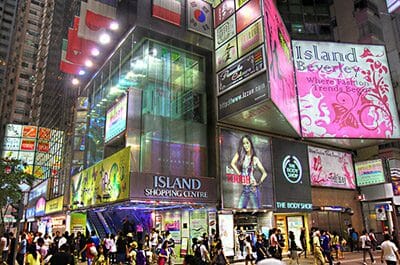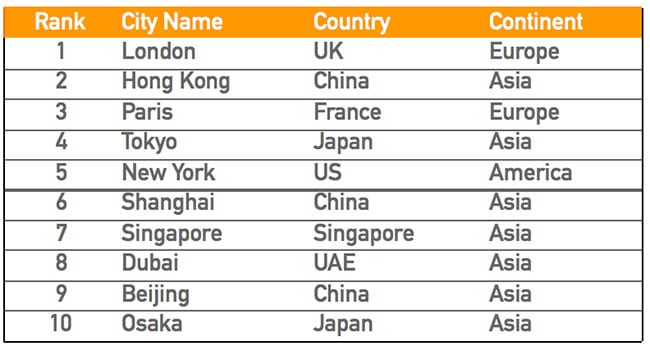Despite the region’s cooling economy, seven of the 10 cities with the most luxury retailers are found in Asia, according to a just-issued JLL report.
The Destination Retail 2016 report lists Shanghai, Beijing, Taipei, Singapore, Osaka and Tokyo among the cities with the most luxury retailers, with Hong Kong second only to London. The analysis by the property consultancy tabulates open and pending stores, and focuses solely on retailers’ own networks, including franchises. Retailer concessions, second-line brands, multi-label stores and branded shops within department stores are excluded from the tally.
The study, which was published for the first time this year, looked at 240 international retail brands across 140 cities holding a significant presence in at least two global regions, including those in Europe, the Middle East, Africa, Asia Pacific and the Americas.
Top 10 Cities for Global Cross-Border Luxury Retailer Attractiveness

Source: JLL
“The list reflects very accurately the demand from retailers for particular cities,” said Tammy Hu, JLL’s marketing director for Greater China. “The interesting trend in the coming years will be to see how much the second and third-tier Chinese cities move up the leaderboard.”
Hu noted that Shanghai and Beijing, usually the starting points for international retailers in China, are globally ranked sixth and eighth. “As brands further expand in China, the hubs of Chengdu, Chongqing, Shenzhen and Tianjin will rise greatly,” Hu predicted. “We have also seen a lot of demand from new brands coming to Sydney and Melbourne. And in the coming years, we will see them rise up the international rankings, too.”
The growing sophistication of the Asian market is a particular lure for high-end luxury brands, Hu said. Ultimately, levels of wealth and degrees of fashion-consciousness in a market are the two biggest decision-drivers for most retailers. “The retailer needs to have the confidence that the consumer is able to afford their brand, as well as being willing to try it,” Hu said. “For some of the more fashion-forward brands, how fashionable the consumer is plays a bigger role, as the consumer needs to be able to understand the brand and see value in the design as something special.”
Overall, Asia’s luxury retailer presence is expected to grow, Hu noted. “The list is constantly evolving, and we expect over the coming years as more emerging markets in APAC become wealthier that more Asian markets will attract international retailers.
Hong Kong Still Asia’s Fashion Gateway

Despite the downturn, retail centres such a Causeway Bay helped Hong Kong to grab the #2 spot
Hong Kong’s prominent showing on the list underlines its gateway status, according to James Assersohn, Director of Retail for Asia Pacific, JLL. “Hong Kong remains Asia’s leading luxury shopping destination, with many retailers using it as a springboard for expansion into Mainland China,” says Assersohn.
He added: “While there has been a noticeable slowdown in luxury sales in the city due to China’s slowing economy and the government’s anti-corruption crackdown, Hong Kong continues to attract many high-spending Chinese tourists. More broadly, the dominance of Asian cities in the index highlights the attractiveness of the region to retailers, thanks to its burgeoning middle classes and growing levels of affluence.”
While China is on the rise, Japan remains a magnet for so-called “retail tourism,” the JLL report concludes. Tokyo has seen a revival in luxury retailers because of the Yen’s devaluation since 2012. International visitors rose 47 percent in 2015 over the previous year, with the largest customer base arriving from mainland China, according to JLL.
Shanghai is also booming, JLL notes, and Assersohn called the city “trend-setting. Thanks to a diverse economy and wealthy consumer base, Shanghai has become a favourite place for international brands to test the Chinese market and gain brand exposure, sometimes bypassing Hong Kong in the process.”
Meanwhile, overall performance of the luxury retail sector in Asia will depend not only on economic growth, but also will be affected by the volume of travel and rising number of affluent households, Assersohn said.
“Strong forecast growth of high-income households in Asian cities over the next 15 years, in particular, should help to keep Asia at the forefront of luxury spending growth, both domestically and abroad,” said Assersohn.

Leave a Reply